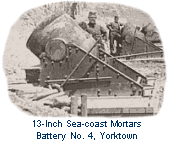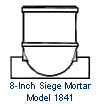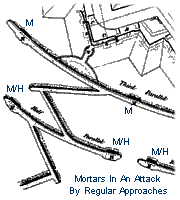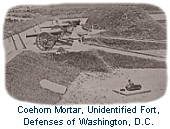 A
short cannon with a chambered bore designed to fire hollow projectiles at
high elevation along an arcing trajectory. Mortar fire was generally inaccurate,
that is, it was very difficult to obtain the same point of impact with repeated
firings, sine the high trajectory of projectiles made them even more subject
to the effects of wind and weather than other smoothbore pieces of artillery.
Their fire was therefore usually delivered toward a limited area rather than
a specific target. A
short cannon with a chambered bore designed to fire hollow projectiles at
high elevation along an arcing trajectory. Mortar fire was generally inaccurate,
that is, it was very difficult to obtain the same point of impact with repeated
firings, sine the high trajectory of projectiles made them even more subject
to the effects of wind and weather than other smoothbore pieces of artillery.
Their fire was therefore usually delivered toward a limited area rather than
a specific target.
At the time of the American Civil War mortars used in the United States service
were divided into three main categories: heavy sea-coast mortars which included
10 and 13 inch mortars; light siege and garrison mortars which included 8
and 10 inch mortars; and Coehorn mortars which could be moved and maneuvered
by a few men without any special equipment. Different models of the sea-coast
and siege and garrison mortars were used during the war: older Model 1841
mortars were distinguished by trunnions positioned at the rear of the
 piece
while Model 1861 mortars had piece
while Model 1861 mortars had
 trunnions
positioned at the mid-point of the tube even with the center of gravity and
lacked the exterior barrel features of the older model. The form given the
chamber was also modified from a conical shape used in the older model to
a hemispherical shape used in the newer Model 1861 mortars. trunnions
positioned at the mid-point of the tube even with the center of gravity and
lacked the exterior barrel features of the older model. The form given the
chamber was also modified from a conical shape used in the older model to
a hemispherical shape used in the newer Model 1861 mortars.
Mortars were used in both the attack and defense of all types of fortifications.
In an attack heavy siege mortar batteries were usually established in front
of the second parallel though the high trajectory of their fire made it possible
to establish mortar batteries at any point convenient to the attack. Heavy
mortars
 were
used to bombard the interior of a fortification and harass the garrison's
quarters, set fire to exposed buildings within the fortification, and crush
or demolish the fortifications by the impact and explosion of heavy shells.
Heavy mortars could also be employed in specially designed batteries positioned
along the capitals of salient angles of attacked fortifications to engage
in ricochet fire. Light mortar batteries were usually established within
the third parallel or advanced demi-parallels and were used to more directly
harass the garrison defending the covered way or other outworks immediately
in front of the approaches of the attack. Fire of small Coehorn mortars could
be combined with fire delivered from trench cavaliers to clear the covered
way and allow the attacking saps to crown the crest of the covered in preparation
for the establishment of breaching batteries. were
used to bombard the interior of a fortification and harass the garrison's
quarters, set fire to exposed buildings within the fortification, and crush
or demolish the fortifications by the impact and explosion of heavy shells.
Heavy mortars could also be employed in specially designed batteries positioned
along the capitals of salient angles of attacked fortifications to engage
in ricochet fire. Light mortar batteries were usually established within
the third parallel or advanced demi-parallels and were used to more directly
harass the garrison defending the covered way or other outworks immediately
in front of the approaches of the attack. Fire of small Coehorn mortars could
be combined with fire delivered from trench cavaliers to clear the covered
way and allow the attacking saps to crown the crest of the covered in preparation
for the establishment of breaching batteries.
 In the defense of a fortification mortars could be positioned
under cover of the parapet or rampart where they could not be reached by
besieging batteries' direct fire. Unlike cannon positioned on a fortification's
walls which could be silenced by both direct and ricochet fire, mortars could
be preserved into the final stages of a siege and continue to hamper the
advance of the besieging army's works throughout the course of the siege.
Heavy mortars could be used to counter batter attacking batteries to reduce
their fire or explode their magazines. Both heavy and light mortars could
be used to harass the heads of saps and compel the construction of blindages
which would slow the advance of the saps. When the enceinte was finally breached
small mortars could be massed near the breach and used to help break up assaults. In the defense of a fortification mortars could be positioned
under cover of the parapet or rampart where they could not be reached by
besieging batteries' direct fire. Unlike cannon positioned on a fortification's
walls which could be silenced by both direct and ricochet fire, mortars could
be preserved into the final stages of a siege and continue to hamper the
advance of the besieging army's works throughout the course of the siege.
Heavy mortars could be used to counter batter attacking batteries to reduce
their fire or explode their magazines. Both heavy and light mortars could
be used to harass the heads of saps and compel the construction of blindages
which would slow the advance of the saps. When the enceinte was finally breached
small mortars could be massed near the breach and used to help break up assaults.
|